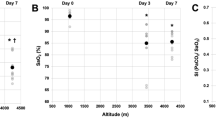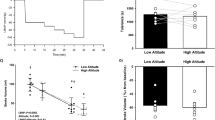Abstract
Purpose
We examined the effects of hypoxaemia on dynamic cerebral autoregulation (dCA) in lowlanders and Sherpa highlanders. We hypothesized that dCA in lowlanders would be reduced to a greater extent in the common carotid artery (CCA) compared to the internal carotid artery (ICA) during acute hypoxia at sea level and at high altitude, whereas Sherpa highlanders would have preserved dCA upon ascent to high altitude.
Methods
dCA was calculated as the change in cerebrovascular conductance during transient hypotension induced via dual thigh-cuff release. Data were collected in 13 healthy lowlanders in normobaric normoxia and hypoxia (FIO2 = 0.11) at sea-level (344 m), and the day after arrival at 3440 m and 5050 m. In addition, 10 healthy Sherpa highlanders were tested at Kathmandu (~ 1400 m), and the day after arrival at 3440 m and 5050 m.
Results
The main findings were that: (1) in lowlanders, dCA in the CCA and ICA were both reduced by ~ 35% during normobaric hypoxia exposure at sea-level (P = 0.06 and P = 0.04, respectively); (2) CCA and ICA dCA were both similarly attenuated by ~ 40% at 5050 m in lowlanders, but not 3440 m, compared to sea-level (both P = 0.04); and (3) in Sherpa, high altitude had no impact on CCA dCA (P = 0.275), indicating intact cerebral autoregulation.
Conclusion
Herein, we provide novel evidence that dCA, assessed via Duplex ultrasound, was attenuated in lowlanders with exposure to normobaric and hypobaric hypoxia, whereas it is potentially preserved in the Sherpa. The clinical implications of attenuated dCA in lowlanders, and the adaptive significance of this response in the Sherpa highlanders, remains to be elucidated.




Similar content being viewed by others
Abbreviations
- AMS:
-
Acute mountain sickness
- CA:
-
Cerebral autoregulation
- CBF:
-
Cerebral blood flow
- CCA:
-
Common carotid artery
- CVC:
-
Cerebrovascular conductance
- HR:
-
Heart rate
- ICA:
-
Internal carotid artery
- KTM:
-
Kathmandu
- MAP:
-
Mean arterial pressure
- MCA:
-
Middle cerebral artery
- NM:
-
Namche Bazaar
- PETCO2 :
-
Partial pressure of end-tidal carbon dioxide
- PYR:
-
Pyramid laboratory
- RoR:
-
Rate of regulation
- SL:
-
Sea level
- SpO2 :
-
Peripheral oxygen saturation
- TCD:
-
Transcranial Doppler ultrasound
References
Aaslid R, Lindegaard KF, Sorteberg W, Nornes H (1989) Cerebral autoregulation dynamics in humans. Stroke 20:45–52
Ainslie PN et al (2008) Differential effects of acute hypoxia and high altitude on cerebral blood flow velocity and dynamic cerebral autoregulation: alterations with hyperoxia. J Appl Physiol (1985) 104:490–498
Ainslie PN, Lucas SJ, Fan JL, Thomas KN, Cotter JD, Tzeng YC, Burgess KR (2012) Influence of sympathoexcitation at high altitude on cerebrovascular function and ventilatory control in humans. J Appl Physiol (1985) 113:1058–1067
Bailey DM et al (2009) Altered free radical metabolism in acute mountain sickness: implications for dynamic cerebral autoregulation and blood-brain barrier function. J Physiol 587:73–85
Birch AA, Neil-Dwyer G, Murrills AJ (2002) The repeatability of cerebral autoregulation assessment using sinusoidal lower body negative pressure. Physiol Meas 23:73–83
Brassard P, Ferland-Dutil H, Smirl JD, Paquette M, Le Blanc O, Malenfant S, Ainslie PN (2017) Evidence for hysteresis in the cerebral pressure-flow relationship in healthy men. Am J Physiol Heart Circ Physiol 312:H701–h704
Carter HH et al (2016) Evidence for shear stress-mediated dilation of the internal carotid artery in humans. Hypertension 68:1217–1224
Claassen JAHR, Levine BD, Zhang R (2009) Dynamic cerebral autoregulation during repeated squat-stand maneuvers. J Appl Physiol 106:153–160 (Bethesda, Md: 1985)
Coverdale NS, Gati JS, Opalevych O, Perrotta A, Shoemaker JK (2014) Cerebral blood flow velocity underestimates cerebral blood flow during modest hypercapnia and hypocapnia. J Appl Physiol (1985) 117:1090–1096
Giller CA, Bowman G, Dyer H, Mootz L, Krippner W (1993) Cerebral arterial diameters during changes in blood pressure and carbon dioxide during craniotomy. Neurosurgery 32:737–741 (Discussion 741–732)
Guo ZN et al (2019) Changes in cerebral autoregulation and blood biomarkers after remote ischemic preconditioning. Neurology 93:e8–e19
Hamner JW, Cohen MA, Mukai S, Lipsitz LA, Taylor JA (2004) Spectral indices of human cerebral blood flow control: responses to augmented blood pressure oscillations. J Physiol 559:965–973
Hoiland RL, Ainslie PN (2016) CrossTalk proposal: the middle cerebral artery diameter does change during alterations in arterial blood gases and blood pressure. J Physiol 594:4073–4075
Hoiland RL et al (2019) UBC-Nepal expedition: phenotypical evidence for evolutionary adaptation in the control of cerebral blood flow and oxygen delivery at high altitude. J Physiol 597:2993–3008
Horiuchi M, Endo J, Dobashi S, Kiuchi M, Koyama K, Subudhi AW (2016) Effect of progressive normobaric hypoxia on dynamic cerebral autoregulation. Exp Physiol 101:1276–1284
Iwamoto E, Bock JM, Casey DP (2018) Blunted shear-mediated dilation of the internal but not common carotid artery in response to lower body negative pressure. J Appl Physiol (1985) 124:1326–1332
Iwasaki K, Ogawa Y, Shibata S, Aoki K (2007) Acute exposure to normobaric mild hypoxia alters dynamic relationships between blood pressure and cerebral blood flow at very low frequency. J Cereb Blood Flow Metab 27:776–784
Iwasaki K, Zhang R, Zuckerman JH, Ogawa Y, Hansen LH, Levine BD (2011) Impaired dynamic cerebral autoregulation at extreme high altitude even after acclimatization. J Cereb Blood Flow Metab 31:283–292. https://doi.org/10.1038/jcbfm.2010.88
Jansen GF, Krins A, Basnyat B, Bosch A, Odoom JA (2000) Cerebral autoregulation in subjects adapted and not adapted to high altitude. Stroke 31:2314–2318
Jansen GF, Krins A, Basnyat B, Odoom JA, Ince C (2007) Role of the altitude level on cerebral autoregulation in residents at high altitude. J Appl Physiol (1985) 103:518–523
Levine BD, Zhang R, Roach RC (1999) Dynamic cerebral autoregulation at high altitude. Adv Exp Med Biol 474:319–322
Minhas JS, Panerai RB, Robinson TG (2018) Modelling the cerebral haemodynamic response in the physiological range of PaCO2. Physiol Meas 39:065001
Nishimura N, Iwasaki K, Ogawa Y, Aoki K (2010) Decreased steady-state cerebral blood flow velocity and altered dynamic cerebral autoregulation during 5-h sustained 15% O2 hypoxia. J Appl Physiol (1985) 108:1154–1161
Ogoh S, Nakahara H, Ainslie PN, Miyamoto T (2010) The effect of oxygen on dynamic cerebral autoregulation: critical role of hypocapnia. J Appl Physiol (1985) 108:538–543
Ogoh S, Lericollais R, Hirasawa A, Sakai S, Normand H, Bailey DM (2014) Regional redistribution of blood flow in the external and internal carotid arteries during acute hypotension. Am J Physiol Regul Integr Comp Physiol 306:R747–751
Querido JS, Ainslie PN, Foster GE, Henderson WR, Halliwill JR, Ayas NT, Sheel AW (2013) Dynamic cerebral autoregulation during and following acute hypoxia: role of carbon dioxide. J Appl Physiol (1985) 114:1183–1190
Roach RC, Hackett PH, Oelz O, Bartsch P, Luks AM, MacInnis MJ, Baillie JK (2018) The lake louise acute mountain sickness score. High Alt Med Biol 19:4–6
Sato K, Fisher JP, Seifert T, Overgaard M, Secher NH, Ogoh S (2012) Blood flow in internal carotid and vertebral arteries during orthostatic stress. Exp Physiol 97:1272–1280
Smirl JD et al (2014) Cerebral pressure-flow relationship in lowlanders and natives at high altitude. J Cereb Blood Flow Metab 34:248–257
Subudhi AW et al (2014) AltitudeOmics: cerebral autoregulation during ascent, acclimatization, and re-exposure to high altitude and its relation with acute mountain sickness. J Appl Physiol (1985) 116:724–729
Subudhi AW, Panerai RB, Roach RC (2009) Acute hypoxia impairs dynamic cerebral autoregulation: results from two independent techniques. J Appl Physiol (1985) 107:1165–1171
Subudhi AW, Panerai RB, Roach RC (2010) Effects of hypobaric hypoxia on cerebral autoregulation. Stroke 41:641–646
Subudhi AW, Grajzel K, Langolf RJ, Roach RC, Panerai RB, Davis JE (2015) Cerebral autoregulation index at high altitude assessed by thigh-cuff and transfer function analysis techniques. Exp Physiol 100:173–181
Thomas KN, Lewis NC, Hill BG, Ainslie PN (2015) Technical recommendations for the use of carotid duplex ultrasound for the assessment of extracranial blood flow. Am J Physiol Regul Integr Comp Physiol 309:R707–720
Tiecks FP, Lam AM, Aaslid R, Newell DW (1995) Comparison of static and dynamic cerebral autoregulation measurements. Stroke 26:1014–1019
Tymko MM, Kerstens TP, Wildfong KW, Ainslie PN (2017) Cerebrovascular response to the cold pressor test - the critical role of carbon dioxide. Exp Physiol 102:1647–1660
Tzeng YC, Ainslie PN (2014) Blood pressure regulation IX: cerebral autoregulation under blood pressure challenges. Eur J Appl Physiol 114:545–559
Tzeng YC, Panerai RB (2018) CrossTalk proposal: dynamic cerebral autoregulation should be quantified using spontaneous blood pressure fluctuations. J Physiol 596:3–5
Tzeng YC et al (2012) Assessment of cerebral autoregulation: the quandary of quantification. Am J Physiol Heart Circ Physiol 303:H658–671
Van Osta A, Moraine JJ, Melot C, Mairbaurl H, Maggiorini M, Naeije R (2005) Effects of high altitude exposure on cerebral hemodynamics in normal subjects. Stroke 36:557–560
Verbree J et al (2014) Assessment of middle cerebral artery diameter during hypocapnia and hypercapnia in humans using ultra-high-field MRI. J Appl Physiol (1985) 117:1084–1089
Verbree J, Bronzwaer A, van Buchem MA, Daemen M, van Lieshout JJ, van Osch M (2017) Middle cerebral artery diameter changes during rhythmic handgrip exercise in humans. J Cereb Blood Flow Metab 37:2921–2927
Willie CK et al (2014) Regional cerebral blood flow in humans at high altitude: gradual ascent and 2 wk at 5050 m. J Appl Physiol (1985) 116:905–910
Willie CK et al (2018) UBC-Nepal expedition: an experimental overview of the 2016 University of British Columbia Scientific Expedition to Nepal Himalaya. PLoS ONE 13:e0204660
Willie CK et al (2011) Utility of transcranial Doppler ultrasound for the integrative assessment of cerebrovascular function. J Neurosci Methods 196:221–237
Wilson MH et al (2011) Cerebral artery dilatation maintains cerebral oxygenation at extreme altitude and in acute hypoxia—an ultrasound and MRI study. J Cereb Blood Flow Metab 31:2019–2029
Woodman RJ et al (2001) Improved analysis of brachial artery ultrasound using a novel edge-detection software system. J Appl Physiol (1985) 91:929–937
Acknowledgements
This study was performed within the framework of the UBC International Research Expedition to Nepal. We thank the research station staff for friendly accommodation. We are grateful to the members of the UBC International Research expedition to the Ev-K2 CNR pyramid laboratory for invaluable help with organization and implementation of this research study.
Funding
This study was supported by the Natural Sciences and Engineering Research Council of Canada (P.N.A.), the Canadian Foundation for Innovation and a Canada Research Chair (P.N.A.). M.M.T. was supported by a Natural Sciences and Engineering Research Council of Canada Doctoral CGS award.
Author information
Authors and Affiliations
Contributions
MMT and PNA conceived and designed the research study; all authors helped with data collection; MMT analyzed the data, prepared the figures, and drafted the manuscript; all authors interpreted the experiment results; all authors edited and approved the final version of manuscript.
Corresponding author
Ethics declarations
Conflict of interest
No conflicts of interest, financial or otherwise, are declared by the authors.
Additional information
Communicated by Guido Ferretti.
Publisher's Note
Springer Nature remains neutral with regard to jurisdictional claims in published maps and institutional affiliations.
Rights and permissions
About this article
Cite this article
Tymko, M.M., Hansen, A.B., Tremblay, J.C. et al. UBC-Nepal expedition: dynamic cerebral autoregulation is attenuated in lowlanders upon ascent to 5050 m. Eur J Appl Physiol 120, 675–686 (2020). https://doi.org/10.1007/s00421-020-04307-7
Received:
Accepted:
Published:
Issue Date:
DOI: https://doi.org/10.1007/s00421-020-04307-7




